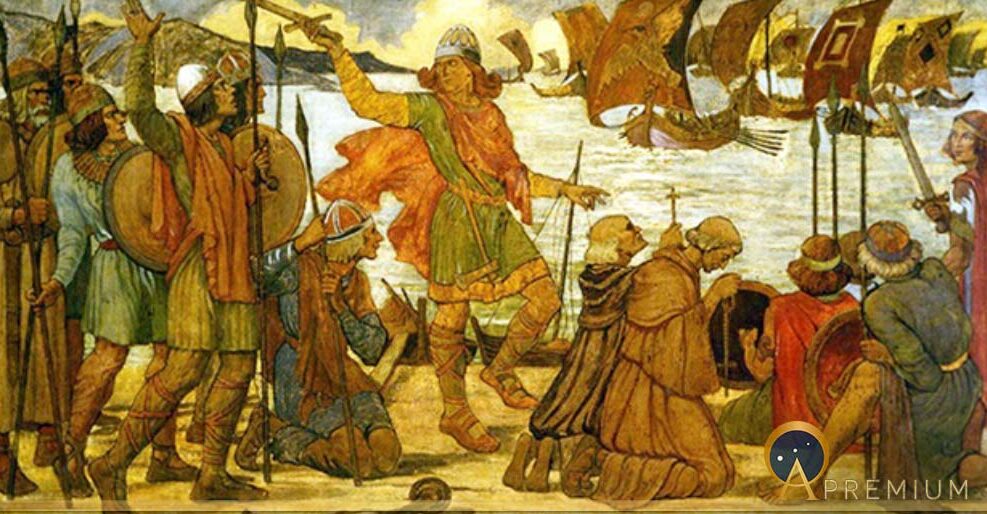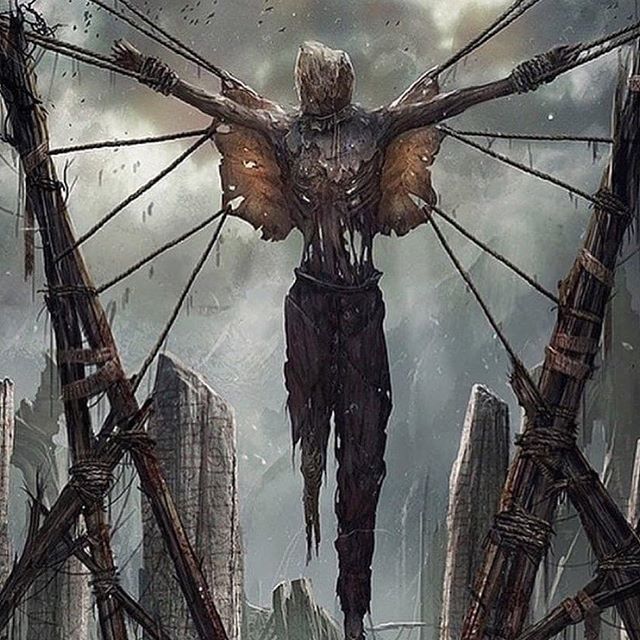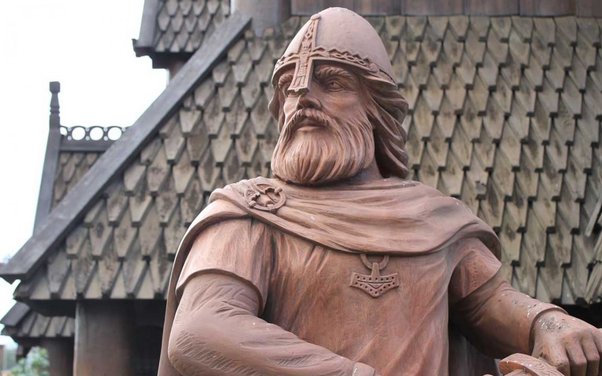Ivar Ragnarsson, known as Ivar the Boneless, was a Viking warlord of Danish origin.
He ruled over a territory spanning parts of modern-day Denmark and Sweden but is best known for his invasion of several Anglo-Saxon kingdoms.
Summary
ToggleDid Ivar the Boneless Really Exist ?
Ivar the Boneless is a historical character who did indeed exist. He was one of the sons of the legendary Viking king Ragnar Lothbrok, who lived in the 9th century. While the details of his life are difficult to establish with certainty, historians generally agree that “Ivar” was a real person.
However, like many historical figures of that time, Ivar the Boneless’s life is surrounded by myths and legends. For instance, it is said that he suffered from a bone disease that prevented him from walking or fighting, which earned him his nickname “Boneless.” However, some historians believe that this nickname might have been given to Ivar due to his cruelty in battle rather than because of a medical condition.
Despite the uncertainties about his life and the legends surrounding him, Ivar the Boneless remains an important historical figure in Viking history, and his name is associated with many stories and legends of that era.
Ivar the Cunning : One of Ragnar Lodbrok’s Sons
According to the Icelandic saga “The Tale of Ragnar Lodbrok,” Ivar was the youngest son of the legendary Viking king Ragnar Lodbrok and his wife Aslaug Sigurdsdottir. He would have had brothers Björn Ironside, Halfdan Ragnarsson, Hvitserk, Sigurd Snake-in-the-Eye, and Ubbe. It is possible that he was adopted—a common Viking practice—perhaps to secure dynastic control.
Some stories recount that Ragnar learned from a seer that he would have many famous sons. He became obsessed with this prophecy, which almost led to a tragic event when he attempted to kill Ivar but couldn’t. Ivar later exiled himself after his brother Ubbe attempted to usurp Ragnar’s place, thereby gaining Lodbrok’s trust.

He is believed to be an authentic character
The Vikings did not leave written records of their history—most of what we know comes from Icelandic sagas (notably the “Saga of the Sons of Ragnar”), but other historical sources and accounts of conquered peoples corroborate the existence and activities of Ivar the Boneless and his brothers and sisters.
The main Latin source that extensively discusses Ivar is the “Gesta Danorum” (“Deeds of the Danes”), written in the early 13th century by Saxo Grammaticus.
The Meaning of His Peculiar Nickname : Ivar the Boneless
Regarding the meaning of Ivar the Boneless’s nickname, it is important to note that the exact meaning remains uncertain because there are several theories and speculations about it. However, here are some possible explanations that could be addressed in the article:
- Ivar the Boneless’s nickname could be a reference to his legendary skill in dismembering and dismantling enemies in battles, particularly by depriving them of their spines. This kind of injury could have been fatal, thus making Ivar a formidable and fearsome warrior.
- Some historians have suggested that Ivar the Boneless’s nickname might have been a wordplay on his father’s name, Ragnar Lodbrok, which literally means “hairy trousers.” The Old Norse word for “bone” is “bein,” which sounds similar to “bryn,” meaning “hair.” Thus, Ivar the Boneless’s nickname could be a humorous way of poking fun at his father and his name.
- Another possible explanation is that Ivar the Boneless’s nickname does not refer to violent actions or wordplay but rather to a physical deformity that affected his spine. This theory is less popular but is still discussed in some academic circles.
It is important to emphasize that the exact meaning of Ivar the Boneless’s nickname is still a subject of debate, and these theories are speculative.
Ivar Ragnarsson : Leader of the “Great Heathen Army”

Ivar’s father, Ragnar Lodbrok, had been captured during a raid in the Kingdom of Northumbria and was killed after being thrown into a pit filled with venomous snakes on the orders of Northumbria’s king, Ælla. His death prompted several of his sons to rally and establish a unified front with other Norse warriors against several Anglo-Saxon kingdoms, reclaiming lands previously claimed by Ragnar.
Ivar and his brothers Halfdan and Ubba invaded Britain in 865, leading a significant Viking force described in the Anglo-Saxon Chronicle as the “Great Heathen Army.”
Ivar the Boneless Known for His Exploits in the British Isles :
Ivar’s forces landed in East Anglia to commence their invasion. With little resistance encountered, they moved north into Northumbria, capturing York in 866. In March 867, both King Ælla and deposed King Osberht joined forces against their common enemy. Both were killed, marking the beginning of Viking occupation of certain parts of England.
Ivar would have installed Egbert, a puppet ruler, in Northumbria and then led the Vikings to Nottingham in the Kingdom of Mercia. Aware of this threat, King Burgred of Mercia sought the assistance of King Æthelred I, King of Wessex, and his brother, the future King Alfred (“the Great”). They besieged Nottingham, forcing the outnumbered Vikings to withdraw to York without a fight.
In 869, the Vikings returned to Mercia, then to East Anglia, and defeated King Edmund “the Martyr” (so named for refusing to renounce his Christian faith, leading to his execution). Ivar apparently did not take part in the Viking campaign to take Wessex from King Alfred in the 870s, as he had left for Dublin.
Ivar the Boneless : The Ruthless Warrior
Ivar the Boneless was known for his exceptional ferocity and was described as the “cruelest of the Norse warriors” by chronicler Adam of Bremen around 1073.
He had a reputation for being a “berserker,” a type of Viking warrior who fought in an uncontrollable fury, akin to a trance (hence the English word “berserk”). The name is derived from their reputed habit of wearing a cloak (a “serkr” in Old Norse) made from a bear’s skin (“ber”) into battle.
According to some accounts, when the Vikings captured King Ælla, he was subjected to the “blood eagle,” a gruesome form of execution involving torture, as revenge for his order to kill Ivar’s father in a snake pit.
The Viking Blood Eagle :
The blood eagle involved cutting the victim’s ribs by the spine and then breaking them to resemble blood-stained wings. The lungs were then pulled out through the back wounds. However, some sources suggest that this torture might have been fictional.

Ivar the Boneless and King Olaf the White :
The story of Ivar the Boneless and King Olaf the White dates back to the Viking era in Norway in the 10th century.
Ivar the Boneless was a Viking warrior renowned for his strength and bravery in battle. He had gained great fame in Norway and had won many battles against his people’s enemies.
One day, King Olaf the White decided to challenge Ivar the Boneless to a duel. The king was a great warrior himself, but he had heard of Ivar’s exploits and wanted to test his own strength against this renowned warrior.
The duel took place in front of a crowd of onlookers. Ivar was a formidable fighter, but he had one weakness: his legs were so thin that he was sometimes called “Ivar the Boneless.” King Olaf the White knew how to exploit this weakness by using kicks to unbalance his opponent.
Ultimately, Ivar was defeated and fell to the ground. King Olaf the White could have killed him, but he decided to spare his life on the condition that Ivar convert to Christianity. Ivar accepted this condition and became a devout Christian.
The story of Ivar the Boneless and King Olaf the White is a popular tale in Norway, showcasing the strength and bravery of Viking warriors but also their vulnerability against cunning opponents. It also illustrates how Christianity began to take hold in Scandinavia during the Viking era.

The Death of Ivar the Boneless :
Ivar’s death is a historical event that occurred in the 9th century during the Viking invasions of England.
Who Killed Ivar the Boneless ?
Regarding his death, there are several versions of the story. One of the most common versions recounts that Ivar was killed in battle during a skirmish with Anglo-Saxon forces in the York region, England. According to this version, Ivar was buried in York.
Another version of the story claims that Ivar died peacefully in his bed in Ireland, where he had retired after facing defeat in England. This version of the story is based on an Icelandic saga, which tells that Ivar was buried in a church in Ireland.
It is challenging to determine which version of the story is more accurate because historical sources are scarce and often contradictory. However, the death of Ivar left a lasting impression on popular imagination, and his story continues to captivate people worldwide.
Ivar the Boneless Could Be Buried in Repton, England :
Professor Martin Biddle, an emeritus fellow of the University of Oxford, suggests that the skeleton of a 2-meter-tall Viking warrior discovered during excavations in the St. Wystan’s cemetery in Repton could be that of Ivar the Boneless.
The unearthed body was surrounded by the remains of at least 249 bodies, indicating that it belonged to a prominent Viking war leader. In 873, the Great Army is believed to have traveled to Repton to spend the winter, and intriguingly, the “Saga of Ragnar Lodbrok” also indicates that Ivar was buried in England.
Examinations revealed that the warrior died in a savage and brutal manner, contradicting the theory that Ivar suffered from osteogenesis imperfecta, although the question of whether the skeleton is indeed that of Ivar the Boneless remains highly controversial.
The Descendants of Ivar the Boneless :
Historical sources are not very clear about Ivar’s descendants, but according to some legends, he had several children.
One of the most well-known stories claims that Ivar had a son named Sigtrygg Ivarsson, who became the king of Dublin in Ireland. Sigtrygg was said to be an ally of the Vikings and played a significant role in Viking raids in Ireland. He was also involved in battles against local kings and other Viking chiefs for control of the region.
However, as with Ivar’s life itself, the details of Sigtrygg Ivarsson’s life are often challenging to establish with certainty due to the nature of historical sources from that era. Therefore, some of the stories and legends surrounding him might be exaggerated or inaccurate.
Overall, even though the descent of Ivar the Boneless is uncertain, he is widely regarded as one of the most important and formidable Viking leaders of his time, and his name remains associated with many stories and legends from the Viking period.
FAQs about Ivar the Boneless :
Ivar the Boneless was a legendary Viking leader.
The exact meaning of his nickname is uncertain but might be due to a physical peculiarity or his flexibility.
His historical existence is debated and is often considered a legendary figure.
He is famous for his roles in the Viking invasions of England.
Norse sagas like the Saga of the Ynglings and Saga of Ragnar Lodbrok.
As a cunning Viking chief and military strategist.
Consult history books, Norse sagas, and documentaries about the Vikings.
Conclusion
In conclusion, Ivar the Boneless remains an enigmatic figure in Viking history, with his historical existence still debated. Whether one considers Ivar the Boneless a historical or mythological character, his legacy remains a vital element of Viking culture and the understanding of that turbulent era in European history.

